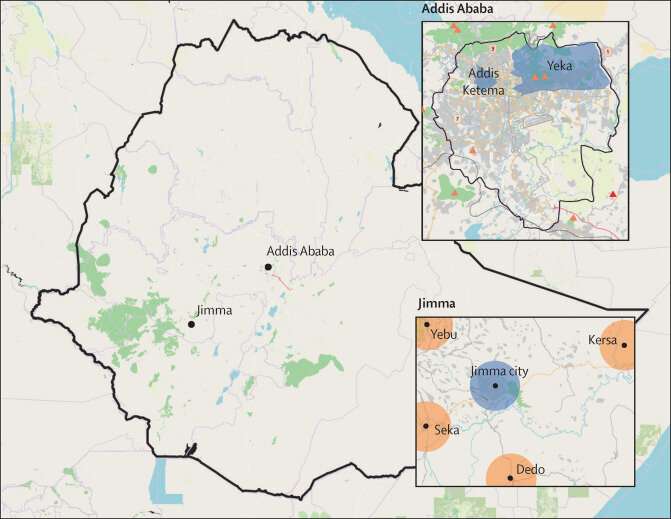
In an Ethiopian-German research collaboration, researchers of the Division of Infectious Diseases and Tropical Medicine at the LMU University Hospital with participation of the University of Bonn investigated blood samples of frontline healthcare workers and residents from urban and rural communities for antibodies. The results suggest that the true COVID-19 prevalence is much higher than previously reported official figures. Therefore, the research team recommends a realignment of the vaccination strategy for Africa. The study is published in the journal The Lancet Global Health.
Since the first reported COVID-19 case in Ethiopia in March 2020, the actual spread and burden of SARS-CoV-2 in the country and in Africa has remained largely unknown. Thus far, official data have provided little information in this regard. Contrary to fears of a humanitarian crisis, relatively few COVID-19 cases (of death) were reported for the African continent at the onset of the pandemic. However, recent studies indicate a high prevalence of SARS-CoV-2 among health workers (e.g., 41.2 percent in the Democratic Republic of the Congo, 45.1 percent in Nigeria). Other sporadic reports provide figures as high as 60 percent among blood donors in South Africa. Therefore, the question arises as to how severely the African continent is affected by the virus and what this means for effective pandemic control strategies in Africa.
In an international collaboration of the Division of Infectious Diseases and Tropical Medicine at the LMU University Hospital and the Ethiopian partners of Jimma University (Jimma Medical Center) and the St. Paul’s Hospital in Addis Abeba, together with the Helmholtz Zentrum Munich, the LMU, the Technical University Munich and the University of Bonn, the research team conducted a study on the spread of SARS-CoV-2 by antibody detection. In their research project, they analyzed blood samples from frontline healthcare workers, urban as well as rural community residents in Jimma and Addis Ababa.
Antibody detection and mathematical modeling
The aim of the cohort study was to obtain epidemiological data on seroprevalence (frequency of specific antibodies in blood serum) and seroincidence (increase in the proportion of antibody-positive individuals over time) in Africa for the first time. In the period between August 2020 and April 2021, the researchers conducted serological testing of blood samples from healthcare professionals at two teaching hospitals in Jimma city and surrounding rural communities, as well as in the Ethiopian capital Addis Ababa. This was done in a total of three study rounds.
In addition, the research group led by Prof. Dr. Jan Hasenauer of the LIMES Institute at the University of Bonn performed a model-based analysis to predict possible levels at which SARS-CoV-2 herd immunity is reached. This model also includes the occurrence of variant strains of the virus.
Dramatic increase in SARS-CoV-2 seroprevalence over time
The results showed that SARS-CoV-2 seroprevalence among medical staff had increased dramatically during the study period: at the Addis Ababa hospital, the team recorded an increase from 10.9 percent in August 2020 to 53.7 percent in February 2021, suggesting a 7-day incidence rate of 2,223 per 100,000 inhabitants. In Jimma the numbers increased from 30.8 percent in November 2020 to 56.1 percent in February 2021, suggesting an incidence rate of 3,810 per 100,000 inhabitants. Urban communities showed a significant increase in seroprevalence to almost 40 percent in early 2021, suggesting incidence rates of 1,622 in Jimma and 4,646 per 100, 000 inhabitants in Addis Ababa, respectively. Seroprevalence in rural areas increased from 18 percent in November 2020 to 31 percent in March 2021, well above the WHO or Johns Hopkins University figures reported to date (of 290,000 infections in a population of 112 million—equivalent to a prevalence of 0.26 percent, as of August 2021).
Call for reorientation of the vaccination strategy for Africa
This study illustrates the dynamics of COVID-19 infections in an African population through the spread of SARS-CoV-2 among healthcare workers, and in urban and rural Ethiopia. The results imply a large wave of infection in Ethiopia, requiring special attention with regards to healthcare burden and disease prevention. In this context, Professor Michael Hoelscher, Director of the Division of Infectious Diseases and Tropical Medicine at the LMU University Hospital, calls for an adaption of the vaccination strategy for African countries: “Our results indicate that immunity—due to passed SARS-CoV-2 infections—is much higher in the African population than assumed. This allows vaccines to be used more effectively,” he says. “For example, the antibody status could be determined before vaccination and, if necessary, only one dose could be vaccinated as a booster. In addition, this allows for a targeted use of the vaccine, especially in high-risk groups and the elderly.”
University of Bonn

